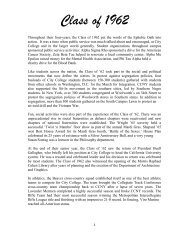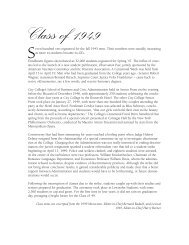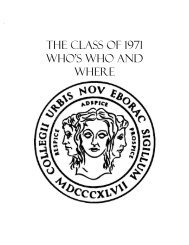them. I gulped. What to say? Did I know? Maybe I drew unconsciously on the Socratic method ofteaching, or maybe I was just fumbling, but I asked a question: “Suppose we don’t get bombed out ofexistence, how will you feel afterward if you have to live with your decision?” <strong>The</strong>y looked at eachother rather sheepishly and held hands, then turned to me, said “Thanks” and walked out. Next weekthe crisis was over, and I never asked. But I’ll never forget that moment.<strong>The</strong> next year, in November 1963, still located uptown, I was walking between classes from the newsouth campus to the old north campus when I passed some students at a car with the radio on. In shock,they were repeating, “He’s dead.” Within minutes we heard the gong of a huge bell sounding from thetower atop Shepard Hall. Buell Gallagher had mounted that long-unused staircase and was pulling thebell rope. We counted: forty-six rings for the forty-six years of life now cut short for President John F.Kennedy. That tolling remains glued in my memory!My experience at the downtown campus was also broadening. Uptown, students learned English literature;downtown they learned world literature, and I was able, for the first time, to employ what I hadstudied of Greek drama and Latin literature at Columbia. Later, I would introduce those courses atYork.1966-92: Work on my dissertation had gone slowly, as I had grabbed every extra opportunity to supportmy family, including ghost editing other dissertations and teaching part-time at schools like Berlitz,because my instructor’s salary at CCNY excluded paychecks during the summer. Moreover, my doctoraterequired passing tests in translation of French, German, and Latin. <strong>The</strong> French—after some solidreview of what I had learned in high school, had got me through my Masters. And now, I wished I hadcompleted the BA with Latin at <strong>City</strong>; but I studied it on my own and took a summer course in Cicero,and managed to pass it; then, drawing on some of the Yiddish I had studied with Max Weinreich at<strong>City</strong> (studied so that Vera’s family couldn’t talk about me behind my back right in front of my eyes),and taking another extra course in German medieval literature (taught in German) to strengthen one ofmy doctoral areas of concentration, I passed the German test, translating Heinrich Heine.But all this had slowed me down, and I was writing a dissertation that should have included review ofmaterials buried in the Bodleian Library at Oxford. I could no more afford to go to England than to themoon. And sure enough, as I was nearing completion of a first draft, an English woman, wife of a barristerand bearing the title “Lady,” produced a book published by Oxford University Press that containedmy essential thesis, but was bolstered by those previously unpublished scraps from the Bodleian. InAmerican universities, we declared thesis topics well in advance and so, were safeguarded against suchcompetition by a central checking agency, but not against a non-university student working independentlyabroad. My thesis advisors asked, “What will you write instead?” I pulled out one section of thedissertation and examined its materials in greater detail. I launched an expansion of that towards dissertationlength. So as I approached reappointment in late 1964, I was warned that I probably wouldnot be reappointed for 1965. A new department administration had been voted in and they were likelyto go for well-published hot shots. Whatever was left of my earlier reputation among out-of-powersenior faculty at <strong>City</strong> had lost the glow of wunderkind and I acknowledged that I needed a new beginningelsewhere.<strong>The</strong> colleges of <strong>The</strong> <strong>College</strong> of the <strong>City</strong> of New York, which had included <strong>The</strong> <strong>City</strong> <strong>College</strong> of-, <strong>The</strong>Hunter <strong>College</strong> of-, <strong>The</strong> Brooklyn <strong>College</strong> of-, and <strong>The</strong> Queens <strong>College</strong> of-, were now combined andexpanded with community college campuses to become <strong>The</strong> <strong>City</strong> University of New York. I appliedfor and got a position at the suddenly expanding Queensborough Community <strong>College</strong> (so I was still inCUNY). After a year, I was invited to head the evening division of its Department of English. <strong>The</strong> followingyear, 1966, the president of QCC was named to head a new senior college, which would eventuallybe called York, and he invited me and a half dozen other QCC functionaries to join him. We
shook hands on the appointment, but it contained the proviso that I have my Ph.D. in hand. I hadalready defended my dissertation. <strong>The</strong>re remained only the editorial changes and final submissionof copy. <strong>The</strong>se I had delayed out of sheer poverty—no money for typing, degree fees, etc.—but Inow pushed as I should have before, and got the degree in hand so that I could be an Assistant Professorof English at York, with the glorious annual salary of $8,500, when it opened in 1967.My early York years were devoted to making a go of the college itself. I chaired committees, wrotethe bulletin, served as delegate to the newly formed University Senate, supervised a special alternativecurriculum for more venturesome students, and after five years, when, under University regulations,we had to create individual discipline departments, I was elected first Chair of English, aposition in which I remained through three-year re-elections for twenty years before giving it upand nominating my successor in 1992.By the end of the sixties, American colleges had changed. We had gone through the disillusionmentof Camelot, the rise of hard rock and Hugh Heffner and the pill—those virgins of 1962 would haveseemed quaint—the riots of Newark, Detroit and LA, the killings at Kent State and Jackson Mississippi,the Vietnam protests, and the 1969 Democratic Convention—all this had left students bothjaded and hard wired to push for change. York, after four years of piggy-backing on the QCC campus,moved to Jamaica. A CUNY-wide open admissions policy made it hard to group students byability levels; major attempts to do so came out of CCNY and the personality of Mina Shaughnessy,who died of cancer shortly thereafter; and from University-wide financial programs like SEEK,which helped get kids from destitute families through college. Criticism of open admissions, largelyfrom such now-seen-as-elite classes as ours of ’53, was often condemning. But students in whathad once been our circumstances were now suburban applicants for SUNY schools like Binghamton,Buffalo, Albany, and Stony Brook or private colleges. At CUNY, broken families were therule. Stay-at-home parents, like many of ours, were seldom to be found. We were no longer talkingabout the Harvard on the Hudson, or any other NYC waterways. Our undergraduate experience, ofexcellent students and some very good teachers (let’s be honest, how many great ones can youcount in your major that would require more than five fingers?) was now replaced by some verypoor students requiring great teaching. New York’s financial crises in the seventies—“Drop Dead”from Gerald Ford and receivership under Abe Beam and Ed Koch— produced drastic retrenchment—layingoff of non-tenured faculty—and rumors of campus closings. My own publishing wasmore in matters of administration than in literary scholarship (including op-ed pieces in the Timesand Newsday and debates with a CUNY chancellor in the Daily News).Now it seemed that my early talents for law were being given room for expression after all. Maybeit was in the blood. Two of my five children went into law, very successfully—until AIDS claimedone—(whose impending death and the need to spend precious time was the main reason for mygiving up the chairmanship). In the later battles over ending open enrollment, led partly in ignoranceby Herman Badillo and by Rudolph Giuliani, students at the senior colleges were to be declared,through testing, to be beyond the need of remediation. I served on a University-wide committee tocreate the process. Put bluntly, once the process was defined and our committee dismissed, theCUNY administration lowered the standard for passing the test, and floods of still under-preparedstudents were allowed in on the grounds that they could do whatever slight patchwork mending oftheir prose was needed by attending tutorial sessions (which within two years, lost much of theirfunding). Our current surge of good students, sitting alongside some ill-prepared, owes largely tothe recession, which has made CUNY comparatively attractive again. But what I describe as aCUNY problem is much wider. Ivy League students no longer read much or write that well either.A quick note about my life as a grammarian: in 1982 (before the computer age) I co-created a
- Page 3 and 4: I think of the Main Building in ear
- Page 5 and 6: HAROLD ADELSON, Ph.D.Liberal Arts &
- Page 7 and 8: Alfred Baker: majored in mechanical
- Page 9 and 10: public school career, was: “It do
- Page 11 and 12: and especially to those who taught
- Page 13 and 14: Judge Herman Cahn, B.A., J.D.: was
- Page 15: the BSS degree. I sat in Dean Gotts
- Page 19 and 20: Elaine M. David, M.S.Ed.: studied E
- Page 21 and 22: William G. Drinnan, B.C.E., P.E.: I
- Page 23 and 24: Meanwhile, I was active in communit
- Page 25 and 26: Arthur Freed, B.C.E., P.E., F.N.SPE
- Page 27 and 28: Bernard Jack Gershen, B.E.E., M.S.E
- Page 30 and 31: Norah and I have two daughters and
- Page 32 and 33: Harvey Philip Greenspan, B.S., M.S.
- Page 34 and 35: Ramon Held, B.A., L.L.D.: was a law
- Page 36 and 37: Herbert Hershfang, B.A.: My most vi
- Page 38 and 39: graduate of CCNY. After 56 years, w
- Page 40 and 41: Herb Isaacs: My mother called me He
- Page 42 and 43: David M. Jacobowitz, B.S., M.S., Ph
- Page 44 and 45: I am a Past-President and long-time
- Page 46 and 47: Jerry N. Koral, B.S., Ph.D.: Jerry
- Page 48 and 49: -drolysis pilot plants and built tw
- Page 50 and 51: Fred Lipschitz, Ph.D.: I received m
- Page 52: At Jackson and Tull in Maryland, th
- Page 57 and 58: -sition he held for seven years and
- Page 59 and 60: Paul M. Parker: I was born in 1928
- Page 61 and 62: I was employed as an engineer at th
- Page 63 and 64: Edward S. Plotkin, B.E., M.B.A., P.
- Page 65 and 66: proposed the design of communicatio
- Page 67 and 68:
labs in New York City. He said “N
- Page 69 and 70:
›son), Brigadoon (Charley Dalrymp
- Page 71 and 72:
A moment at City stands out in Bern
- Page 73 and 74:
-gram, as I couldn’t take the sam
- Page 75 and 76:
Eugene Sklar: I was born and raised
- Page 77 and 78:
Jerry Somerdin, B.S., M.A: was a ma
- Page 79 and 80:
Dr. Herbert Weissbach: I graduated
- Page 82 and 83:
Professor Stanley A. Wolpert, B.A.,






